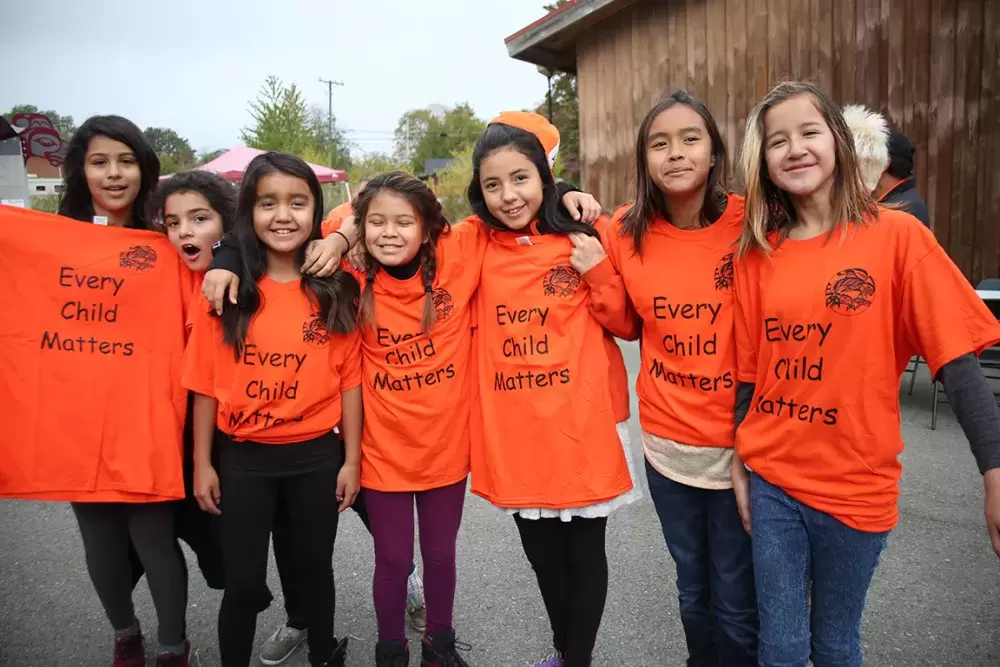Kelly Sport was suddenly overcome.
He was addressing the walkers who had gathered on the site of the former Alberni Indian Residential School to commemorate Orange Shirt Day Sept. 30, and had just pointed to a building used by the school.
He had attended AIRS “and it wasn’t a very good experience. It scarred us for life... That was where the bad memories started was in that building,” Sport said.
Then overwhelming emotion struck him so he could speak no more. People came to stand beside him in support.
“It came back,” Sport struggled to say, holding his hand over his heart. “There is a child that came out again… oh, that’s tough.”
Hesquiaht Chief Councillor Richard Lucas could empathize with those emotions. “Residential school issues are over legally,” he said, but “it’s still with our people.”
It’s for that reason, in part, that the Nuu-chah-nulth Tribal Council’s Quu’asa (Mental Health) department commemorated Orange Shirt Day and remembered the legacy of the residential school system.
About 100 people took part in a brief walk from the Tseshaht longhouse, down along the River Road portion of highway 4 and then back again. Passersby along the highway honked their horns in support of all the people wearing bright orange shirts.
Students from Haahuupayak School joined the Quu’asa team, the staff of the Nuu-chah-nulth Tribal Council and residential school survivors. After the walk, there was a lunch served beside the residential school memorial, called “Strength from Within”, designed by Connie Watts.
Children played around and on the sculpture, their orange shirts in sharp contrast to the darkness and shadow of a part of the sculpture, representing the days of the residential school era. The other parts represent the healing process, and ongoing health.
See the story here: http://www.hashilthsa.com/news/2014-10-02/art-installation-ensures-people-will-never-forget-or-deny-what-happened-airs
Sport said some survivors have grasped, over the years, that what happened in residential schools was not right. It was not legal. “I have accepted that it wasn’t my fault.”
He said it warmed his heart to see the children around him that day unburdened by the residential school experience.
“We were angry when we came out of here, and now I can see smiles on these children’s faces.”
NTC Vice President Ken Watts pointed to the nearby totem pole raised by the Tseshaht to acknowledge residential school students and, particularly, late Art Thompson.
“He was an amazing man who went to court over what happened to him in residential school, which ultimately led to something bigger.”
That something bigger is at the root of Canada’s journey to the residential schools settlement agreement and the Truth and Reconciliation Commission’s work.
Watts said survivors don’t want people to forget what happened in the schools. “We want Canadians and everyone to know what happened here.”
There is a quote written on the “Strength from Within” monument that says the Haahuupayak school, run by Tseshaht and celebrating its 40th anniversary, is a testament to the fact that architects of the residential school system didn’t kill the Indian in the child, as was their goal.
“Kids are still surviving and they are learning the language and the culture,” Watts said, and acknowledged the children of survivors who are ending the cycle of the things that happened to their parents and grandparents in residential schools.
“We are in a really unique time,” said Watts. “Canadians are all interested in a thing called reconciliation. But it’s up to our kids to move forward with healthy lives.”
Marie Samuel acts as a cultural support worker, teaching children Nuu-chah-nulth traditions. She said First Nations need to take care of the children and remember that survivors still need help today, to reach out to them and let them know they are not alone.
“We need one another for help and support, to give each other strength,” she said.
Orange Shirt Day was created by Phyllis Jack. She went to a mission school in 1973. Though they were poor, her grandmother found the money to purchase some special clothes for her first day of school.
“I remember going to Robinson store and picking out a shiny orange shirt that had string lace up in front and it was so bright and exciting, just like I felt to be going to school,” emcee Stan Matthews read her story to the crowd.
“When I got to the mission, they stripped me and took my clothes, including my orange shirt. I never saw it again. I did not understand why they wouldn’t give it back to me. It was mine. The color orange has always reminded me of that and how my feelings didn’t matter. How no one cared and how I felt like I was worth nothing.”
Chief Lucas said he was sent to Christie school in 1956. He was picked up in Nootka when he had turned seven. There were two priests, a brother and a RCMP officer.
What little clothes he had were taken away from him, but that’s not all that was taken away, he said.
They weren’t allowed to speak their language; he couldn’t sit with his sisters or talk to them. They took away abundant familiar food.
“They not only took our clothes away, they took everything away, our pride.
I’m glad we are doing what we are doing today.”
See our gallery of photos here: http://www.hashilthsa.com/gallery/orange-shirt-day







